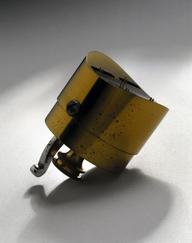


Phage typing machine used to determine bacteria strains present in multiple samples inoculated onto petri dishes, developed at the Public Health Laboratory Service, used particularly to identify strains of salmonella, 1959.
Developed at the Public Health Laboratory Service (PHLS) in London, England, this machine was used to determine bacteria strains present in samples in Petri dishes. This process is known as ‘phage typing’. A phage is a virus that can destroy bacteria. Phage types are very particular in the bacteria they can attack, so bacteria can be characterised by the phage that destroy them. The PHLS investigates cases of infectious diseases that can be easily passed from one person to another, such as measles. They used this machine to identify strains of salmonella – a bacterium that causes food poisoning and a range of stomach infections.
Details
- Category:
- Public Health & Hygiene
- Object Number:
- 1996-402
- Measurements:
-
overall: 323 mm x 483 mm x 516 mm, 7.16 kg
- type:
- phage typer
- credit:
- Public Health Laboratory Service




